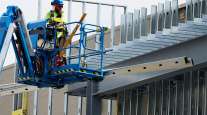Economy Expanded at Revised 1.4% Rate in Second Quarter

The U.S. economy expanded more in the second quarter than previously estimated, reflecting a smaller drag from business spending on structures and equipment.
Gross domestic product rose at a 1.4% annualized rate, compared with a prior estimate of 1.1%, Commerce Department figures showed Sept 29. Gross domestic income, which reflects all the money earned by consumers, businesses and government agencies, was revised to show a 0.2% drop rather than a gain.
Households are doing the heavy lifting for the economy, making up for tepid business investment and lackluster demand from overseas. On the heels of robust hiring and nascent wage gains, consumer spending is projected again to drive growth in the third quarter.
“It’s clearly been enough to carry us through,” Scott Brown, chief economist for Raymond James Financial Inc. in St. Petersburg, Florida, said about household spending. “The U.S. economy is generally in good shape” for the second half even as “conditions around the rest of the world are still sluggish.”
Household consumption, which accounts for about 70% of the economy, was revised to 4.3% from a prior estimate of 4.4%.
The upward revision to GDP also reflected a smaller drag from inventories and higher exports.
The median forecast in a Bloomberg News survey called for a 1.3% gain in GDP. Economists’ estimates for the value of all goods and services produced ranged from 0.9% to 1.7%.
The latest estimate is the last of three for the quarter before annual revisions next year. The economy grew at a 0.8% pace from January through March.
Investment in nonresidential structures, including office buildings and factories, fell at a 2.1% rate, rather than a previously reported 8.4% drop. Spending on equipment fell at a 2.9% pace, compared with 3.7% in the prior report.
Combined with a 9% increase in intellectual property products, non-residential fixed investment advanced at a 1% annualized pace in the second quarter. It was previously reported as falling 0.9%.
Final sales to private domestic purchasers rose at a 3.2% rate in the April through June period, revised from a previously reported 3% pace. The category reflects consumer and business spending and excludes government purchases, exports and inventories.
The decline in gross domestic income compares with a prior estimate of a 0.2% gain and was due to a downward revision to state and local tax receipts as well as collections from oil and gas producers.
Before-tax corporate profits fell 4.3% in the second quarter from the same time last year, compared with a 4.9% drop previously reported, according the the Commerce Department. It was the fifth consecutive decline and the worst streak since the end of the recession in mid-2009.
The economy will grow at a 2.8% rate in the third quarter before cooling to 2.4% in the last three months of the year, according to the median forecast of economists surveyed by Bloomberg from Sept. 2 to Sept. 7.




